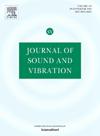Baseline-free bridge damage identification using proper orthogonal decomposition and continuous wavelet transform with limited sensors
IF 4.3
2区 工程技术
Q1 ACOUSTICS
引用次数: 0
Abstract
Traditional modal identification methods usually fail to provide high-resolution mode shape estimations due to insufficient sensor observations, thus significantly reducing their effectiveness. This study introduces a novel baseline-free bridge damage identification method that requires a minimal number of sensors. An analysis method, named POD-CWT transform method, is introduced. This method incorporates proper orthogonal decomposition (POD) and continuous wavelet transform (CWT). It can effectively identify the locations of damage in girder bridges subjected to loads from moving vehicles. The displacement transducers are arranged in an equidistant manner and used to measure the bridge displacement responses under moving loads. POD is employed to obtain a component matrix, wherein each column represents the vibration mode and dynamic information of the bridge. High-resolution mode shapes are obtained by filtering this dynamic information through a low-pass filter. The first mode is processed using CWT to extract the wavelet energy content, which serves as the structural damage indicator. When structural damage is present, the corresponding wavelet energy content profile at the damaged location undergoes an abrupt change. The effectiveness of this approach is verified by numerical simulations and experimental tests. The presented algorithm eliminates the need for non-damage baseline data and significantly reduces the number of required sensors without sacrificing estimation accuracies.
求助全文
约1分钟内获得全文
求助全文
来源期刊

Journal of Sound and Vibration
工程技术-工程:机械
CiteScore
9.10
自引率
10.60%
发文量
551
审稿时长
69 days
期刊介绍:
The Journal of Sound and Vibration (JSV) is an independent journal devoted to the prompt publication of original papers, both theoretical and experimental, that provide new information on any aspect of sound or vibration. There is an emphasis on fundamental work that has potential for practical application.
JSV was founded and operates on the premise that the subject of sound and vibration requires a journal that publishes papers of a high technical standard across the various subdisciplines, thus facilitating awareness of techniques and discoveries in one area that may be applicable in others.
 求助内容:
求助内容: 应助结果提醒方式:
应助结果提醒方式:


